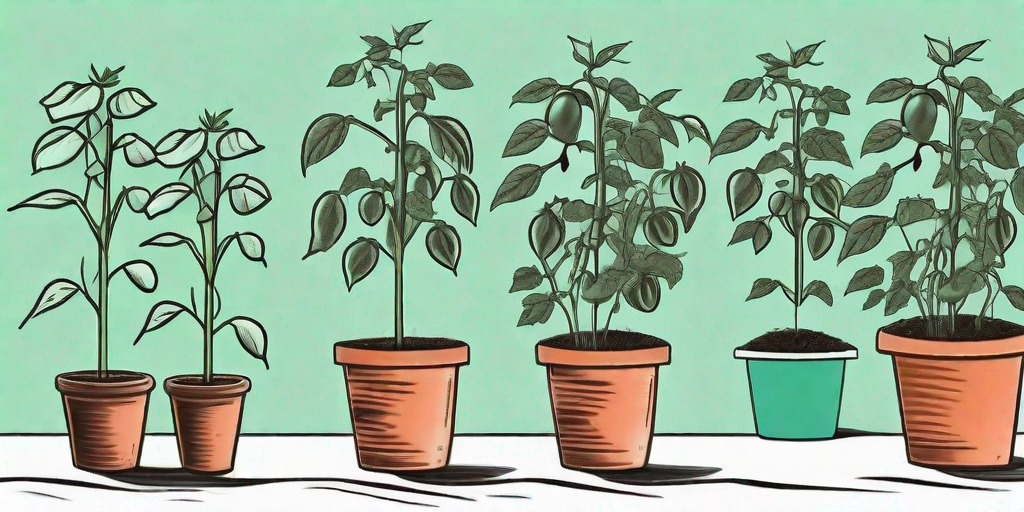
As the sun begins to set on another fruitful tomato season, you might be wondering what to do with your beloved tomato plants. Don't worry, we've got you covered! This comprehensive guide will provide you with all the tips and tricks you need to wrap up the season and prepare for the next. So, let's dive in, shall we?
Understanding Your Tomato Plants
Before we get into the nitty-gritty of end-of-season care, it's important to understand a little bit about tomato plants. Tomatoes are warm-season crops that thrive in temperatures between 55 and 95 degrees Fahrenheit. They are annuals, which means they complete their life cycle in one season.
However, in some warmer climates, tomato plants can be treated as perennials, producing fruit year-round. Knowing the type of tomato plant you have and the climate in which you live can greatly influence how you wrap up your tomato season.
Types of Tomato Plants
There are two main types of tomato plants: determinate and indeterminate. Determinate, or bush tomatoes, grow to a certain height, typically 3 to 4 feet, and then stop. They produce all their fruit at once, which is great for canning and sauce-making.
Indeterminate tomatoes, on the other hand, continue to grow and produce fruit until killed by frost. These are the types you typically see in grocery stores. Knowing the type of tomato plant you have can help you determine when and how to wrap up the season.
End of Season Care
Now that we've covered the basics, let's get into the heart of the matter: end-of-season care. This involves several steps, including harvesting, cleaning, and preparing for the next season.
Harvesting
As the season winds down, it's time to harvest any remaining tomatoes. Green tomatoes can be picked and ripened indoors if frost threatens. Simply place them in a paper bag with a ripe banana or apple. The ethylene gas produced by the ripe fruit will speed up the ripening process.
Alternatively, you can leave the tomatoes on the vine until the first frost. Just be sure to cover the plants with a frost blanket to protect them from the cold.
Cleaning
Once all the tomatoes have been harvested, it's time to clean up. Remove all plant debris from the garden to prevent diseases from overwintering. This includes any fallen tomatoes, leaves, and even the tomato plants themselves.
It's also a good idea to rotate your crops each year to prevent soil-borne diseases. So, if you planted tomatoes in a particular spot this year, try to plant a different crop there next year.
Preparing for Next Season
Finally, it's time to prepare for the next season. This involves several steps, including soil preparation, choosing the right varieties, and proper planting techniques.
Start by adding compost or other organic matter to your soil. This will improve its structure and fertility, ensuring a bountiful harvest next year. Next, choose the right tomato varieties for your climate and personal preferences. Finally, plant your tomatoes properly to ensure they get off to a good start.
FAQs
Can I leave my tomato plants in the ground over winter?
Unless you live in a very warm climate, it's generally not a good idea to leave tomato plants in the ground over winter. Tomatoes are susceptible to a number of diseases, many of which can overwinter in the soil. Removing your plants at the end of the season can help prevent these diseases from spreading.
What can I do with green tomatoes at the end of the season?
Green tomatoes can be ripened indoors, pickled, or used in recipes like green tomato salsa or fried green tomatoes. They can also be left on the vine until the first frost, provided you cover the plants with a frost blanket.
How do I prepare my soil for next year's tomato crop?
Start by removing all plant debris from the garden. Then, add compost or other organic matter to improve soil structure and fertility. It's also a good idea to rotate your crops each year to prevent soil-borne diseases.
Wrapping Up
And there you have it! With these smart tips, you'll be well on your way to wrapping up the tomato season like a pro. Remember, the key to a successful tomato season is understanding your plants, providing proper care, and preparing for the next season.
So, as the sun sets on another tomato season, take a moment to appreciate the fruits of your labor. Then, roll up your sleeves and get ready for next year. After all, the end of one season is just the beginning of another. Happy gardening!











